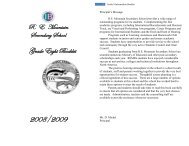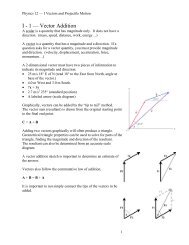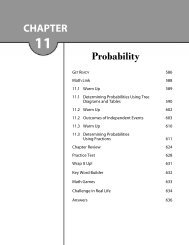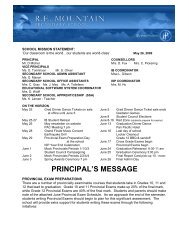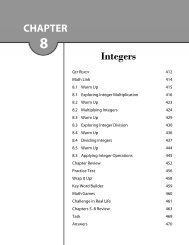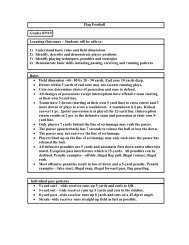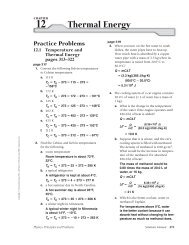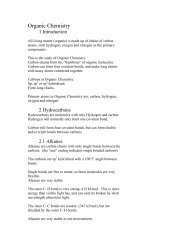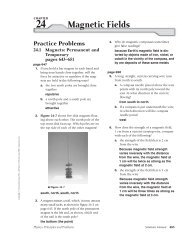Physics Solutions Manual
Physics Solutions Manual
Physics Solutions Manual
Create successful ePaper yourself
Turn your PDF publications into a flip-book with our unique Google optimized e-Paper software.
Copyright © Glencoe/McGraw-Hill, a division of The McGraw-Hill Companies, Inc.<br />
Chapter 15 continued<br />
67. Determine the variation in sound pressure<br />
of a conversation being held at a sound<br />
level of 60 dB.<br />
The pressure variation at 0 dB is<br />
210 5 Pa. For every 20-dB increase, the<br />
pressure variation increases by a factor<br />
of 10. Therefore, 60 dB has a pressure<br />
variation amplitude of 210 2 Pa.<br />
68. A fire truck is moving at 35 m/s, and a car<br />
in front of the truck is moving in the same<br />
direction at 15 m/s. If a 327-Hz siren blares<br />
from the truck, what frequency is heard by<br />
the driver of the car?<br />
v s 35 m/s, v 343 m/s, v d 15 m/s,<br />
f s 327 Hz<br />
<br />
fd fsv vd<br />
v vs<br />
(327 Hz)3 43<br />
15<br />
350 Hz<br />
343<br />
35<br />
Level 3<br />
69. A train moving toward a sound detector<br />
at 31.0 m/s blows a 305-Hz whistle. What<br />
frequency is detected on each of the<br />
following?<br />
a. a stationary train<br />
f d f s v<br />
v<br />
<br />
<br />
vd<br />
vs<br />
335 Hz<br />
b. a train moving toward the first train at<br />
21.0 m/s<br />
f d f s v<br />
v<br />
<br />
<br />
vd<br />
vs<br />
356 Hz<br />
70. The train in the previous problem is moving<br />
away from the detector. What frequency<br />
is now detected on each of the following?<br />
a. a stationary train<br />
f d f s v<br />
v<br />
(305 Hz)(343 m/s 0)<br />
<br />
343 m/s 31.0 m/s<br />
(305 Hz)(343 m/s (21.0 m/s))<br />
<br />
343 m/s 31.0 m/s<br />
<br />
vd<br />
vs<br />
<strong>Physics</strong>: Principles and Problems <strong>Solutions</strong> <strong>Manual</strong> 337<br />
<br />
2.8010 2 Hz<br />
b. a train moving away from the first train<br />
at a speed of 21.0 m/s<br />
f d f s v<br />
v<br />
<br />
<br />
vd<br />
vs<br />
2.6310 2 Hz<br />
15.2 The <strong>Physics</strong> of Music<br />
pages 426–427<br />
Level 1<br />
71. A vertical tube with a tap at the base is<br />
filled with water, and a tuning fork vibrates<br />
over its mouth. As the water level is lowered<br />
in the tube, resonance is heard when the<br />
water level has dropped 17 cm, and again<br />
after 49 cm of distance exists from the water<br />
to the top of the tube. What is the frequency<br />
of the tuning fork?<br />
49 cm 17 cm 32 cm or 0.32 m<br />
1<br />
exists between points of resonance<br />
2<br />
1<br />
0.32 m<br />
2<br />
0.64 m<br />
v 343<br />
m/s<br />
f 540 Hz<br />
0.64<br />
m<br />
72. Human Hearing The auditory canal leading<br />
to the eardrum is a closed pipe that is<br />
3.0 cm long. Find the approximate value<br />
(ignoring end correction) of the lowest<br />
resonance frequency.<br />
L <br />
4 <br />
v<br />
f <br />
(305 Hz)(343 m/s 0)<br />
<br />
343 m/s (31.0 m/s)<br />
(305 Hz)(343 m/s 21.0 m/s)<br />
<br />
343 m/s (31.0 m/s)<br />
v<br />
f <br />
4L<br />
343<br />
m/s<br />
2.9 kHz<br />
(4) ( 0.030<br />
m)<br />
73. If you hold a 1.2-m aluminum rod in the<br />
center and hit one end with a hammer, it<br />
will oscillate like an open pipe. Antinodes<br />
of pressure correspond to nodes of molecular<br />
motion, so there is a pressure antinode<br />
in the center of the bar. The speed of sound





